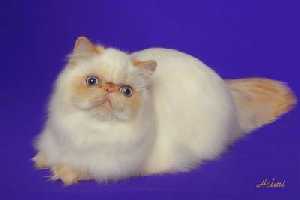 History of Himmies
History of Himmies History of Himmies
History of HimmiesThe Himalayan is known as a hybrid breed. People were looking for a type of cat that had the delicate Siamese mantle and blue eyes over a solid Persian frame. Therefore the essential Himalayan points belong to the Siamese and Persian cats.
This proved more difficult than meets the eye. The attributes sought of long hair, blue eyes, pointed color pattern are the work of recessive genes. This means that the qualities MUST be in both parents to be observed in the offspring. To cross a purebreed Siamese with a purebreed Persian results in non-pointed, short-haired, copper to yellow eyed, longer nosed, bigger eared and dainty scaffolded cats.
These kittens, however, now possess the required genes to produce the "perfect" Himalayan cat. If we were to breed these ugly-ducking Siamese-Persian hybrids, 1 out of 16 kittens will have the desired features.
The earliest know case takes place in the United States and Sweden in the early 1920s. In 1931, Virginia Cobb and Clyde Keeler, associates at the Harvard Medical School, began this experiment. Five years later, the first Himalayan was produced. She was named Debutante. An article was writted in the "American Journal of Heridity" basically giving a detailed recipe for which Debutante was produced.
It was only two decades later that Himalayan cats were recognized as a new breed. Ben Barrett, rancher and cattle judge in Southern Alberta, started his own breeding program. He imported colorpoint longhairs from Brian Sterling-Webb, a British cat fancier who was a majordomo in getting colorpoints officially seated in England. In 1957 at the A.C.F.A. Barrett showed two of his cats. At this show, he was asked to write a breed standard for the Himalayan, a name the longhair acquired between England and Canada.
In 1958, the A.C.F.A. was the first North American cat registry to recognize Himalayans for championship competition. At first, it was unacceptable to breed Himalayans except with other Himalayans. However, in the 1960s it was noted that people sought the Persian build within their Himalayans and it became acceptable to breed Himalayans to Persians. It was not accepted, however, to breed Himalayans to Siameses, as the required genes of blue eyes and color-point were not needed to be contributed ad infinitum.
Two association cat registries that do no accept the Himalayan as a unique breed are the A.C.A. and the C.F.A. They accept the Himalayan on as another Persian color.
The Himalayan has become the most popular breed in the United States. In 1996 the C.F.A. registered 68,948 cats and kittens. Sixty-two percent of these were "Persians", which includes colorpoints and Himalayans.
If you would like to find out more on the history and development of the Himalayan, please check out this website where I was able to obtain my information: "cats and kittens"
 Home Page History of Himmies Kat Kare Kat Kriteria Associations Quebec Breeders Ontario Breeders My Himmie Stories Comments & Questions
Home Page History of Himmies Kat Kare Kat Kriteria Associations Quebec Breeders Ontario Breeders My Himmie Stories Comments & Questions